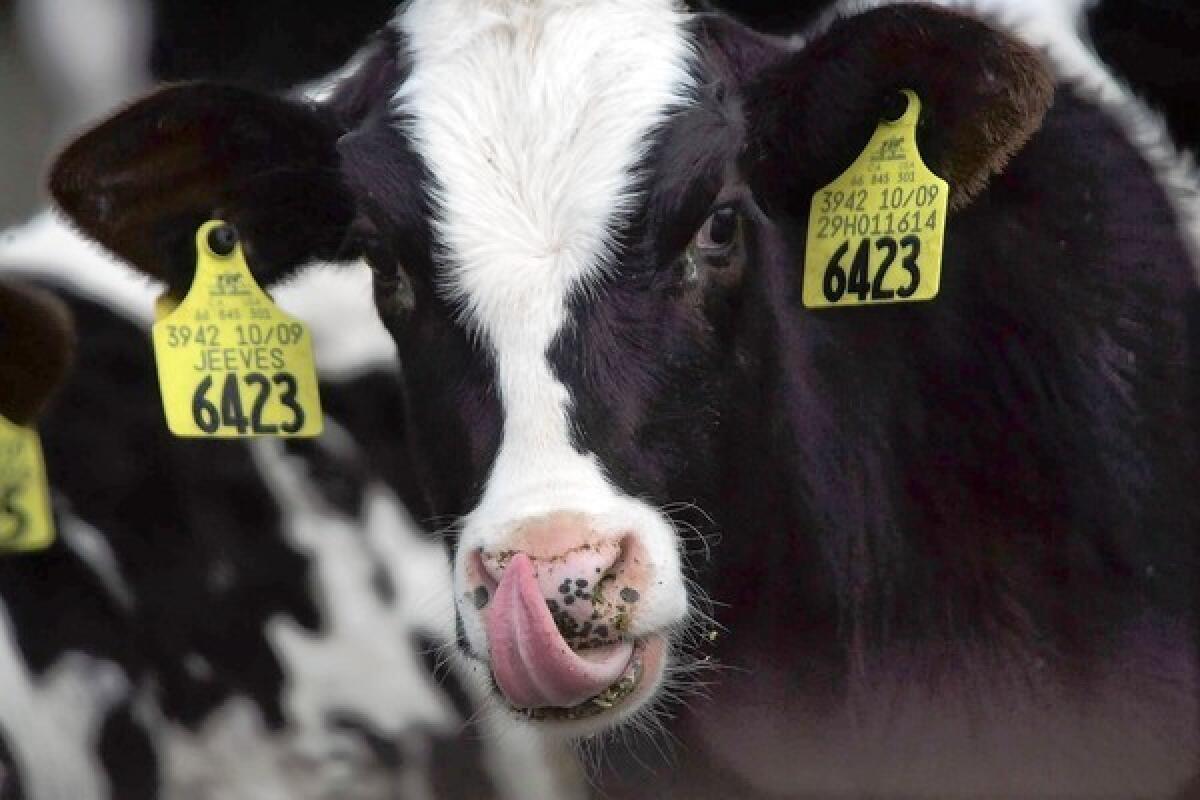FDA changing course on antibiotics in livestock

Only 20% of the antibiotics sold in the U.S. are given to people who are sick with bacterial infections, such as ear and urinary tract infections and pneumonia. Most of the penicillin, tetracycline and other antibiotic drugs used in this country are given to livestock that are perfectly healthy.
Farmers have been putting these medicines in animal feed since the 1950s. They say the drugs help protect herds from infectious diseases and help animals grow faster.
But for at least 40 years, the U.S. Food and Drug Administration has been concerned that the widespread practice may be fueling the growth of human pathogens that are no longer vulnerable to doctors’ front-line drugs.
In the last few weeks, the U.S. Food and Drug Administration has made two rulings addressing the use of antibiotics in animals that will end up as food on our dinner tables:
• On Dec. 22, the FDA pulled the plug on procedures, begun in 1977, that might have ended the practice of feeding penicillin and tetracycline to livestock.
• On Jan. 4, the agency issued an order that prohibits certain uses, including preventive uses, of another class of antibiotics also used to treat pneumonia and other infections in people.
The two moves may seem contradictory. But the FDA asserts that both decisions were made in the interest of preserving antibiotics that are medically important for humans.
Some public health advocates agree that the latest moves indicate a new willingness by the government to tackle the longstanding issue.
In finally dropping its long-stalled plans to limit the use of penicillin and tetracycline in farm animals, the FDA signaled that it intends “to regulate more than just a few drugs,” said Laura Rogers, who directs the Pew Charitable Trusts’ campaign on human health and industrial farming. Seen in that light, last week’s ruling limiting the use of cephalosporin antibiotics in agriculture “is the first step toward a broader regulatory approach,” she said. (The Pew campaign opposes routine use of antibiotics in food animals.)
The science behind antibiotic resistance is a classic story of survival of the fittest. Antibiotics target key life functions in bacteria, killing them or preventing them from multiplying. But individual bugs that survive a drug’s assault will grow and multiply, potentially creating a whole population of drug-resistant bacteria.
Resistance to antibiotics is a growing public health problem across the globe. People infected with resistant pathogens tend to get more severely ill and are harder to treat. Antibiotic resistance adds an estimated $20 billion to healthcare costs in the U.S. each year, including longer hospital stays and the need for more expensive drugs, according to the Centers for Disease Control and Prevention.
However, it’s not clear how much the use of antibiotics in cattle, pigs, chickens and other animals contributes to problems in people.
Those who oppose the practice of putting antibiotics in animals’ food or water point to studies that have found livestock-associated strains of bugs such as salmonella and Staphylococcus aureus in humans.
Decades ago, the FDA commissioned Seattle’s public health department to study salmonella and campylobacter found on meat and in people sick with enteritis. In a 1984 report, researchers found that illness-inducing campylobacter was similar to that found on poultry products. In addition, about 30% of bacteria from both sources were resistant to tetracycline.
Eating contaminated meat isn’t the only way people can become colonized with antibiotic-resistant bacteria. Those who work with farm animals are also at risk. For instance, a Chinese study published in 2010 found antibiotic-resistant Escherichia coli in animals and farmworkers. The year before, researchers in Iowa reported that they found a livestock-associated strain of antibiotic-resistant staphylococcus in pig farm workers.
The World Health Organization, the American Medical Assn. and other major health groups have denounced the practice of feeding human antibiotics to animals. The mere threat that agricultural use could cripple drugs for people is reason enough to take action, they say.
Advocates of the practice refer to scientific reviews that discount the risk to human health. A 2004 paper in the Journal of Antimicrobial Chemotherapy argued that cross-contamination between farm animals and people is a two-way street, with most antibiotic-resistant disease stemming from human use of these drugs. In any event, the authors wrote, illness from bacteria on meat can be prevented with proper cooking — even if the bacteria are resistant to drugs.
Blanket regulations limiting how the drugs are used on animals would remove valuable tools from the veterinarian’s medical bag, according to the American Veterinary Medical Assn. Using the drugs prophylactically allows farmers and ranchers to prevent or control disease outbreaks, especially when animals are kept in close quarters. If drugs are only given to animals after they are visibly ill, disease can spread quickly and risk the lives of an entire herd or flock.
There’s little dispute that livestock animals carry antibiotic-resistant organisms. But there’s all sorts of barriers that prevent those bugs from infecting humans, said Dr. Liz Wagstrom, chief veterinarian for the National Pork Producers Council. They’d have to contaminate the meat at slaughter, survive cooking and be ingested in a large enough dose to make someone ill.
In ending its long-stalled initiative to reconsider penicillin’s and tetracycline’s use in agriculture, the FDA said the “notices of opportunity for a hearing” issued in 1997 were so old that they were essentially useless. Though there was evidence back then that the practice fuels antibiotic resistance, new data would have to be taken into account for such a decision to be made today.
At a minimum, any effort to move forward at this point would have to consider other classes of antibiotics that have become popular since the 1970s and include a rationale for which ones should be targeted, according to the agency.
The FDA’s move may have been prompted by a lawsuit filed by advocacy groups including the Natural Resources Defense Council and the Food Animal Concerns Trust. Convinced that feeding antibiotics to animals is a major public health problem, they were trying to force the FDA to move forward with its plans — not abandon them altogether.
“It’s the FDA’s overcautious attitude,” said Steven Roach, public health program director for FACT. “If anything we have more evidence now than we did in 1977. And they had enough evidence to proceed back then.”
The drugs that were affected by the FDA’s decision are among the oldest around. Tetracycline tops the list of most popular antibiotics, with more than 4 million kilograms used in food animals per year, according to 2009 data collected by the FDA. Penicillin comes in fourth, with about 610,000 kilograms of the drug used each year. (Both figures include drugs used on healthy animals as well as to treat those that are sick.)
Both drugs still are widely used by pork producers but in very specific ways, Wagstrom says. For instance, penicillin (usually in combination with other antibiotics) is fed to weanling pigs because it stimulates growth at this early stage in life.
How antibiotics promote growth is not entirely understood. The drugs may affect gut bacteria in a way that permits food nutrients to be better absorbed, or they may suppress low-level disease, according to Dr. H. Morgan Scott, a professor at Kansas State University’s College of Veterinary Medicine in Manhattan, Kan. “If they’re growing faster, some people would argue they must be healthier.”
The FDA has made other moves to restrict antibiotic use in animals. In 2003, the agency began requiring drug companies to do a risk assessment of drugs given to animals as part of the overall approval process. However, those rules don’t apply to older drugs like penicillin, Roach said.
The FDA is also developing guidelines for the “judicious use” of antibiotics in livestock. These guidelines, first made public in July 2010, are still in draft form. The agency hasn’t set a timeline to finalize them, although it’s considered a priority, according to FDA spokeswoman Stephanie Yao.
But those guidelines will only be voluntary, which is why watchdog groups tried to force the FDA to move forward with the decades-old rules about penicillin and tetracycline, Roach said.
The lawsuit brought by the NRDC, FACT and others to force the FDA to take regulatory action against antibiotics in animal feed is ongoing.
Meanwhile, Rep. Louise Slaughter (D-N.Y.) has introduced legislation to restrict the use of medically important antibiotics in agriculture. The Preservation of Antibiotics for Medical Treatment Act would require the FDA to re-review approvals for drugs currently allowed in animal feed. Slaughter re-introduced the bill last March.






